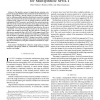Free Online Productivity Tools
i2Speak
i2Symbol
i2OCR
iTex2Img
iWeb2Print
iWeb2Shot
i2Type
iPdf2Split
iPdf2Merge
i2Bopomofo
i2Arabic
i2Style
i2Image
i2PDF
iLatex2Rtf
Sci2ools
TMI
2010
2010
Theoretical Bounds and System Design for Multipinhole SPECT
Abstract—The pinhole camera in single photon emission computed tomography (SPECT) has an inherent trade-off between resolution and sensitivity. Recent systems overcome this to some extent by utilizing multiple pinholes distributed around the imaging object. The present work is a theoretical study on how to optimally construct such systems. We use an analytic model to analyze the multipinhole SPECT geometry and identify the underlying tradeoffs. One of the results is the derivation of the upper bound for the sensitivity, given the geometric resolution and field-of-view (FOV). Reaching this bound requires an infinitely large detector. However, a sensitivity very close to the upper bound can be achieved by a system with realistic proportions. We show that it is usually possible to get a sensitivity that is 95%–99% of the upper bound. Further analysis reveals a trade-off between sensitivity, magnification, and the number of pinholes. Based on this new theory, we develop a strategy f...
| Added | 31 Jan 2011 |
| Updated | 31 Jan 2011 |
| Type | Journal |
| Year | 2010 |
| Where | TMI |
| Authors | Peter Nillius, Mats Danielsson |
Comments (0)

